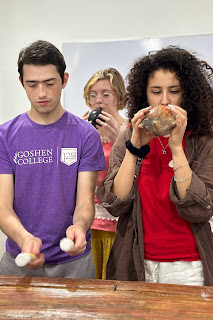During the first part of the student’s time in Merida, meeting and integrating into their host families is probably the most important step in beginning an immersion program. The host families in Mérida are fundamental for the students to adapt to their new urban context.
Another important aspect of
the students' time in Mérida are their Spanish classes, since the language will
allow them to interact and immerse themselves more profoundly in the culture.
During these language classes, the students not only learn grammar and
structure, but they are also able to develop their own linguistic abilities by
sharing, discussing and practicing everyday vocabulary and expressions that
they hear outside of the classroom.
The culture classes are another key part of the program, they help the students understand diverse aspects of the culture, how a Yucatecan family lives, the differences between interacting in an urban or a rural setting, and provide the hidden historical context for what we can see and experience today. The Spanish language the culture classes perfectly complement each other, as the knowledge and confidence acquired in the Spanish classroom allows the students to better write, speak and interact in different contexts in their culture class.
One of the activities that helps to understand many
aspects seen in the culture class is the visit to the Grand Museum of the Mayan
World, where the students could see archeological and historical artifacts that
helps them connect ideas that they are developing throughout the course. This
visit is always very productive since the students already have a general
panorama of the diverse historical processes that the Mayas of Yucatán have
gone through since the pre-hispanic era to the present days.
Another interesting presentation was taught by the architect Rafael Lara Castro who told us about the architectural evolution of the city of Merida. The students were able to learn about the various architectural manifestations from the colonial era, the elements of the urban landscape that show architectural influences of other countries like France, as well as the ways in which Spanish and Mayan architecture was used by Yucatecan architects throughout the history of the city. Finally the students also learned about the ways in which other countries, such as the United States, return to neo-Mayan architecture as an inspiration.









